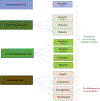Lipid mediators of inflammation and Resolution in individuals with tuberculosis and tuberculosis-Diabetes
- PMID: 31726221
- PMCID: PMC7067657
- DOI: 10.1016/j.prostaglandins.2019.106398
Lipid mediators of inflammation and Resolution in individuals with tuberculosis and tuberculosis-Diabetes
Abstract
Individuals with concurrent tuberculosis (TB) and Type 2 diabetes (DM) have a higher risk of adverse outcomes. To better understand potential immunological differences, we utilized a comprehensive panel to characterize pro-inflammatory and pro-resolving (i.e., mediators involved in the resolution of inflammation) lipid mediators in individuals with TB and TB-DM. A nested cross-sectional study of 40 individuals (20 newly diagnosed DM and 20 without DM) was conducted within a cohort of individuals with active drug-susceptible treatment-naïve pulmonary TB. Lipid mediators were quantified in serum samples through lipid mediator profiling. We conducted correlation-based analysis of these mediators. Overall, the arachidonic acid-derived leukotriene and prostaglandin families were the most abundant pro-inflammatory lipid mediators, while lipoxins and maresins families were the most abundant pro-resolving lipid mediators in individuals with TB and TB-DM. Individuals with TB-DM had increased correlations and connectivity with both pro-inflammatory and pro-resolving lipid mediators compared to those with TB alone. We identified the most abundant lipid mediator metabolomes in circulation among individuals with TB and TB-DM; in addition, our data shows a substantial number of significant correlations between both pro-inflammatory and pro-resolving lipid mediators in individuals with TB-DM, delineating a molecular balance that potentially defines this comorbidity.
Keywords: Diabetes; Inflammation; Leukotrienes; Lipids; Lipoxins; Prostaglandins; Resolvins; Specialized pro-resolving mediators; Tuberculosis.
Copyright © 2019 Elsevier Inc. All rights reserved.
Conflict of interest statement
Declaration of Competing Interest None declared.
Figures





References
-
- Mave V et al. Prevalence of dysglycemia and clinical presentation of pulmonary tuberculosis in Western India. The international journal of tuberculosis and lung disease : the official journal of the International Union against Tuberculosis and Lung Disease 21, 1280–1287, doi:10.5588/ijtld.17.0474 (2017). - DOI - PMC - PubMed
Publication types
MeSH terms
Substances
Grants and funding
LinkOut - more resources
Full Text Sources
Medical

